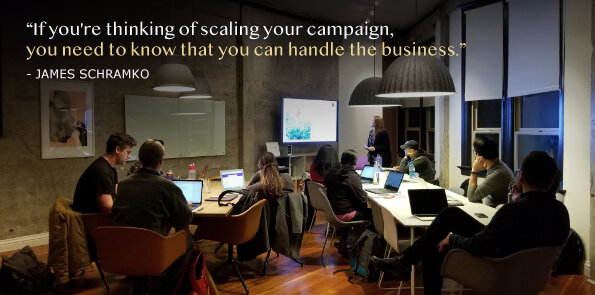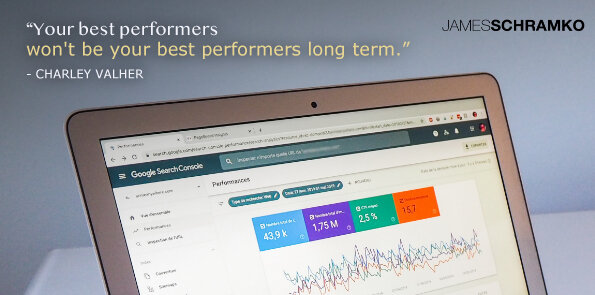Podcast: Download (Duration: 48:09 — 44.9MB)
Get Notified Of Future Episodes Apple Podcasts | Spotify | Amazon Music | Android | Blubrry | Gaana | TuneIn | Deezer | Anghami | RSS | More
Traffic is a mainstay in marketing, says James. One always needs traffic. And in this podcast episode, he welcomes back Charley Valher of Valher Media to unpack the topic – in particular, how to effectively scale ad campaigns.
James and Charley will look at the requirements to successfully scale your marketing.
They’ll discuss ad spend and a multimodal approach to paid ads.
And Charley will provide useful case studies from his experience handling paid traffic for his many clients.
Table of contents
1. The fundamental thing to campaign success
2. Hot, warm, or cold?
3. How much should you spend on ads?
4. Keeping up with the demand
5. When the numbers get hefty…
6. Having a hook that works
7. The multi-modality strategy
8. An example to go with the theory
9. Knowing what the client doesn’t know…
10. Leveraging the client’s data
11. Taking a long-term mindset
12. Widening one’s geography
13. How the terms of payment affect things
14. Other payment-related things to look out for
15. What makes an agency good or average
The fundamental thing to campaign success
The cornerstone of a successful advertising campaign, says James, is an offer that converts effectively; without it, scaling up would be pointless.
Charley concurs, adding that the true test of an offer’s viability comes when it is exposed to a broader audience beyond personal networks (friends, family and the like). An offer that appear successful within a small, familiar circle may fail when marketed to potential customers who have no prior relationship with the brand.
Hot, warm, or cold?
James talks of targeting different “temperatures” in marketing offers, where one starts with the ‘hot’ market of existing customers and then reaches out to ‘warm’ leads and eventually to ‘cold’ prospects. This approach uses the familiarity and trust built with current customers to secure repeat sales before expanding outwards.
Charley says that his services are usually sought after by businesses looking to scale beyond their current networks and achieve more ambitious goals, rather than those content with leveraging their existing networks for sustained, but limited, growth.
James identifies with the latter group, those who run a business with finite capacity, focusing on a comfortable revenue stream and a lifestyle-oriented approach. He contrasts this with businesses that have the potential for scaling, such as those offering products or services that are not constrained by personal time and resources, which are the types of businesses that might benefit from paid traffic to expand their reach.
How much should you spend on ads?
When considering ad spend, it’s crucial to evaluate if the offer not only converts but also generates enough profit to sustain reinvestment into more ads. There’s no one-size-fits-all benchmark for how much revenue should go back into ad campaigns, and this is a key consideration for businesses looking to scale.
Aggressive scaling, says Charley, requires significant ad investment upfront, with the understanding that sales returns will follow. It’s important, he says, to be aware of a business’s sales cycle, especially for high-ticket items with delayed payment structures, which may impact the ability to sustain a scaling strategy due to cash flow constraints.
Charley also points out that businesses with lower-ticket offers that scale up ad spending might initially operate at a loss. Such businesses must depend on strong backend operations and other revenue-generating strategies to eventually turn profitable when scaling traffic campaigns.
Keeping up with the demand
James reflects on the necessity of future-proofing when considering scaling a business, stressing the importance of forecasting labor needs to meet service demands. In his experience, rapid growth can lead to significant challenges, such as an inability to hire quickly enough. This could strain resources and potentially damage a company’s reputation if it fails to deliver on sales.
James recounts the time he drove so much traffic to a program as a super affiliate that the supplier couldn’t keep up. The business collapsed due to the influx of refunds. This led James to pivot his business strategy to a recurring subscription model, turning a loss into a valuable lesson and growth opportunity.
Among the challenges of scaling a business are the mindset shifts needed to handle new levels of operational demands. James and Charley advise business owners to prepare not only for physical capacity constraints but also for the psychological adjustments needed to scale successfully.
When the numbers get hefty…
As advertising costs grows into large sums – think hundreds of thousands or even millions per month – it calls for a significant shift in thinking. Hefty credit card statements from ad spends can be daunting, demanding a change in mindset and approach.
Charley talks of the escalating risks associated with high-level ad spending, where the stakes are much higher and a failed split test could lead to substantial financial loss. This level of expenditure requires thorough testing and a strong money mindset to manage the increased risks effectively.
When accounts scale too quickly without proper preparation, they are vulnerable to significant challenges if strategies fail. Mental fortitude is essential in handling the attendant stress and potential volatility.
Managing large ad accounts, says Charley, is also quite different from handling smaller ones. Strategies that work on a small scale, like niche targeting for modest budgets, may not be effective or feasible when attempting to scale up to much larger ad spends, which require appealing to a broader market.
Having a hook that works
Charley underscores the importance of having a reliable hook before scaling advertising budgets. Testing various lead magnets to see what resonates best with the audience is crucial to minimize risks associated with scaling.
With a case study of a client in the coaching industry, Charley illustrates the need for meticulous testing — they tested 15 different lead magnets to find the one that could scale successfully. Recognizing a winning approach is vital before large-scale application and should be done in different variations to ensure effectiveness.
The multi-modality strategy
Charley emphasizes the strategy of multi-modality in scaling campaigns. He suggests, for instance, deepening engagement with a successful lead magnet by presenting it in various formats to cater to different learning styles, such as auditory and visual. He considers this approach underutilized and highly effective.
When increasing advertising budgets, Charley advises a gradual approach to mitigate risks like supply chain disruptions or prematurely maxing out a platform. Budget and efforts should be expanded progressively, he says, to better handle unexpected challenges.
Charley also advises one consider new advertising platforms only after maximizing the current one. Using a sequential approach, expansion to other platforms like Facebook or YouTube occurs only after the potential of the current platform is fully tapped. Then integrating those platforms can create synergies and cross-pollinate data for remarketing.
An example to go with the theory
Charley acknowledges that without examples, theories can seem too abstract and difficult to relate to practical situations.
James, too, values the relevance of real-world scenarios and recognizes that Charley’s decade and a half of experience over his bring a fresh perspective to contemporary advertising campaigns across various platforms.
Before obliging with a case study, Charley mentions that most clients come to him after they have tried and failed to scale their advertising, comparing the trial-and-error process of ad scaling to a gamble where the advertising platforms make money regardless of the advertiser’s success.
Charley’s example is that of a mortgage broker who, having exhausted their network, tried Facebook ads without success. Charley points out the long payment cycle in mortgage brokering, where payments are made long after the loan settles, making rapid ad scaling risky.
Part of Charley’s strategy was to segment the mortgage broker’s market into distinct categories like first home buyers, investors, and upgraders. Initial assumptions that investors would be the best market were proven wrong by the data, leading to a focused campaign on the ‘mom and dad’ market segment that turned out to be the most successful.
Charley says they then utilized different modalities to engage with the targeted market, and adjusted their advertising budget carefully to align with the client’s cash flow cycle. They started with Facebook, aiming to fully utilize it before moving on to other platforms like YouTube or TikTok, choosing strategic expansion over rapid diversification.
Knowing what the client doesn’t know…
Charley notes there is often a gap between a client’s perception and industry reality, which can be an obstacle in advertising and client education. Frequency, he says, is a useful Facebook ad metric, which indicates how often someone sees an ad and can demonstrate to clients if their current visibility is low.
He shifts to the financial cycle of the mortgage industry, highlighting the delay between making a sale and receiving payment, which can take up to 60 days or more. This lag in payment can affect a broker’s confidence in the effectiveness of advertising campaigns, even though they are closing deals.
Charley and James discuss how mortgage brokers may bridge the cash flow gap between closing deals and receiving payments. Some brokers consider business loans to fund this interim, enabling them to scale more aggressively. Charley also points out that many brokers have built up a financial cushion through networking and prior business, which they can use to leverage growth alongside ad spending.
Leveraging the client’s data
James suggests the importance of businesses understanding their customer base by analyzing their data, particularly for e-commerce where product lines and profitability can be closely examined. He notices that service businesses may not always know their best customer, and stresses data analysis as a key starting point for marketing strategies.
Charley and James discuss the benefits of identifying and focusing on a niche market, using the example of a broker targeting investors. They also touch on the pitfalls of operating in a saturated or overly competitive category, with James of the viewpoint that a business’s talents and resources could be better utilized in a less challenging market.
Testing different market categories is recommended as a valuable investment for businesses of any size, as long as they have some revenue to support it.
Taking a long-term mindset
Charley speaks of the need to adopt a long-term mindset in advertising strategies. He contrasts the levels of trust required to convert customers in the mortgage broker’s investor network versus the more general “mom and dad” category. He suggests that leveraging referrals from satisfied customers can significantly scale up a business, as customers in good deals are likely to recommend services to others.
James adds that customer categories can evolve over time, as people’s circumstances change. He shares his own experience with a broker who has retained his business over the years by proactively negotiating better rates, thus preventing churn and fostering long-term customer loyalty.
Widening one’s geography
Charley introduces the concept of scaling business by expanding geography, using an Australian coaching program as an example. Despite its success in Australia, Charley points out the company has reached a saturation point within the Australian market and encourages tapping the US market to continue growth.
Despite initial reluctance due to operational changes needed to accommodate a different time zone and sales team, the coaching company ultimately explored the US market. The result, Charley reports, is a significant decrease in lead acquisition costs.
Dot com and the US dollar, says James, have been his favorite strategy. Australia, he says, often represents only a small fraction of the global market, and expanding into the US and other regions can dramatically increase a business’s customer base.
How the terms of payment affect things
Charley notes how cash flow impacts the scalability of a business, particularly in coaching programs where being paid in full (PIF) can allow for quicker scaling compared to payments spread over the duration of the program. He observes that businesses with longer cash flow cycles may rely on third-party financing providers to manage cash flow, but he demurs against recommending any specific provider.
James points out the risks involved with payment plans, such as clients not completing payments, the potential for refunds or chargebacks, and the need for a business to understand their metrics before scaling. Charley highlights the significance of fees charged by financing providers, which can take a considerable portion of a business’s margins and may not be suitable for everyone.
There are legal considerations to take into account when setting payment terms. In some jurisdictions, businesses may face legal issues if they charge more for installment payments, as it can resemble a lending practice. James advises consulting a lawyer to navigate these complexities, suggesting that offering a discount for full payment could be a legally sound alternative.
James mentions the importance of easy payment systems for customers, even if the merchant fees are high. And Charley shares his experience of helping a business scale from $20,000 to $200,000 a month in ad spend within three months, attributing success not just to strategy but also to favorable market conditions at the time.
Other payment-related things to look out for
Charley touches on an unexpected issue when scaling up ad accounts: as spending increases, frequent charges can trigger fraud alerts, leading to credit card shutdown by the bank. This results in the inability to run ads, which can be costly. To mitigate this, Charley suggests having multiple credit cards from different providers to manage the risk and ensure continuous ad operation.
Charley also stresses the importance of knowing Facebook policies well, especially when running large accounts. Monitoring the health of an account through Facebook’s Business Manager is crucial to avoid being banned or restricted. He recommends, too, getting verified with Facebook to gain better support, although he admits it might not always be the best.
Charley speaks of the fluctuating nature of ad account performance, and warns that daily monitoring can lead to stress. He suggests that typically there is one outstanding week, two average weeks, and one poor week in a month. Over time, these variations even out, but focusing too closely on daily metrics can lead to unnecessary anxiety.
James compares ad spending to weighing oneself during a health journey, emphasizing that looking at longer-term trends is more important than daily fluctuations. Both agree that in the entrepreneurial journey, one must be prepared for inevitable setbacks and maintain a risk-averse attitude to navigate through the highs and lows of campaign management.
What makes an agency good or average
It’s Charley’s view that the difference between average and good agencies lies in their preparedness and adaptability. Good agencies anticipate that even the best-performing ads will eventually lose their effectiveness due to banner blindness, and are always ready with fresh campaigns to maintain momentum. They operate with the understanding that digital advertising is like tending a garden, requiring constant attention and swift action to changes, in contrast to a set-and-forget approach like pouring concrete.
Preparation is crucial when handling large advertising budgets, says Charley. A common shortfall among average agencies, he says, is a lack of readiness for when an ad campaign stops performing. This can lead to costly delays, whereas good agencies have new strategies lined up and can pivot quickly, ensuring minimal downtime and sustained campaign performance.
Drawing from his experience as a failed day trader, Charley stresses the need for a plan in advertising. He believes having pre-determined rules can help media buyers avoid panic-driven decisions, which often result in poor quality output. Just like disciplined traders, skilled media buyers must manage emotional reactions to maintain quality work and avoid a downward spiral in their campaigns.
Ongoing innovation and foresight, in short, maintain an agency’s edge. By working on the next phase of business before it’s necessary, agencies can prevent client churn and ensure longevity. He takes his responsibility as an agency owner seriously, understanding the significant impact of his work on clients’ businesses, and is committed to providing honest feedback and innovative solutions through his agency.
It’s thoroughness and responsibility like Charley’s, says James, that are crucial traits for success in high-stakes advertising.
If you’d like your paid ads reviewed, look up Charley and his team at ValherMedia.com/review.
Enjoyed the show? Leave us a review on iTunes













Leave a Reply